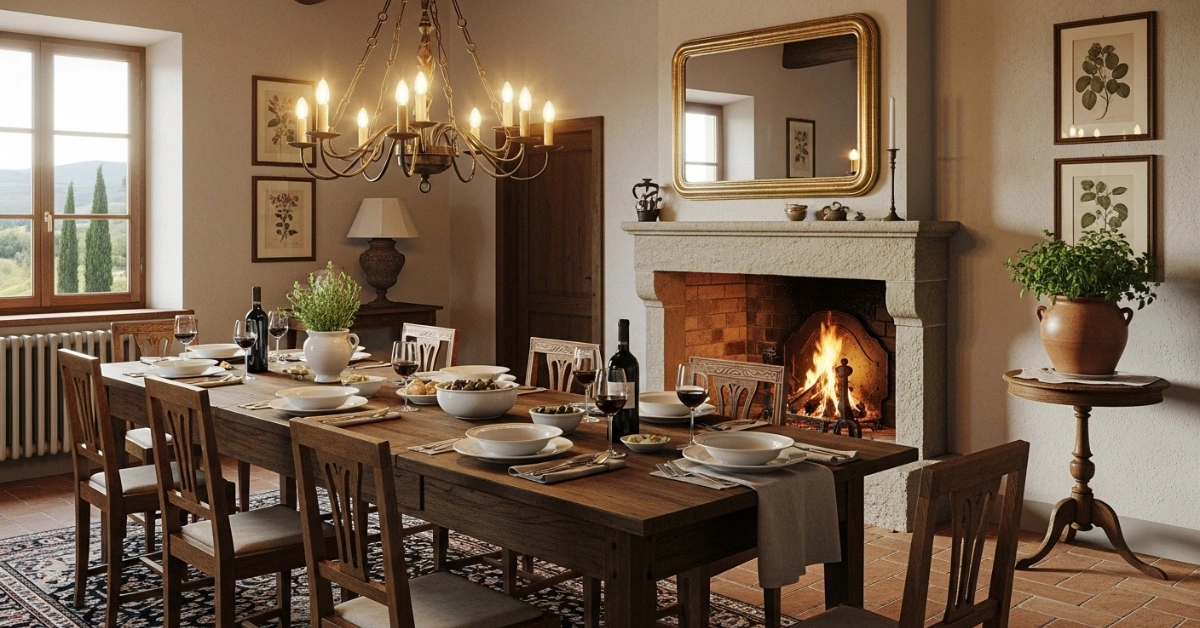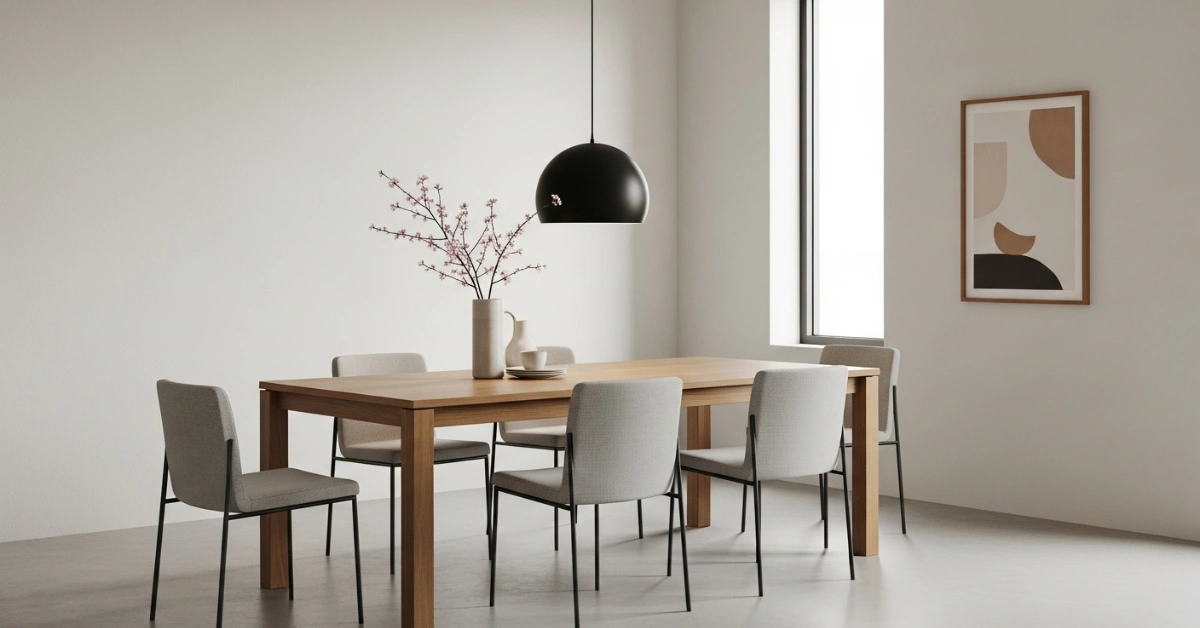31 Industrial Dining Room Ideas for a Modern Look
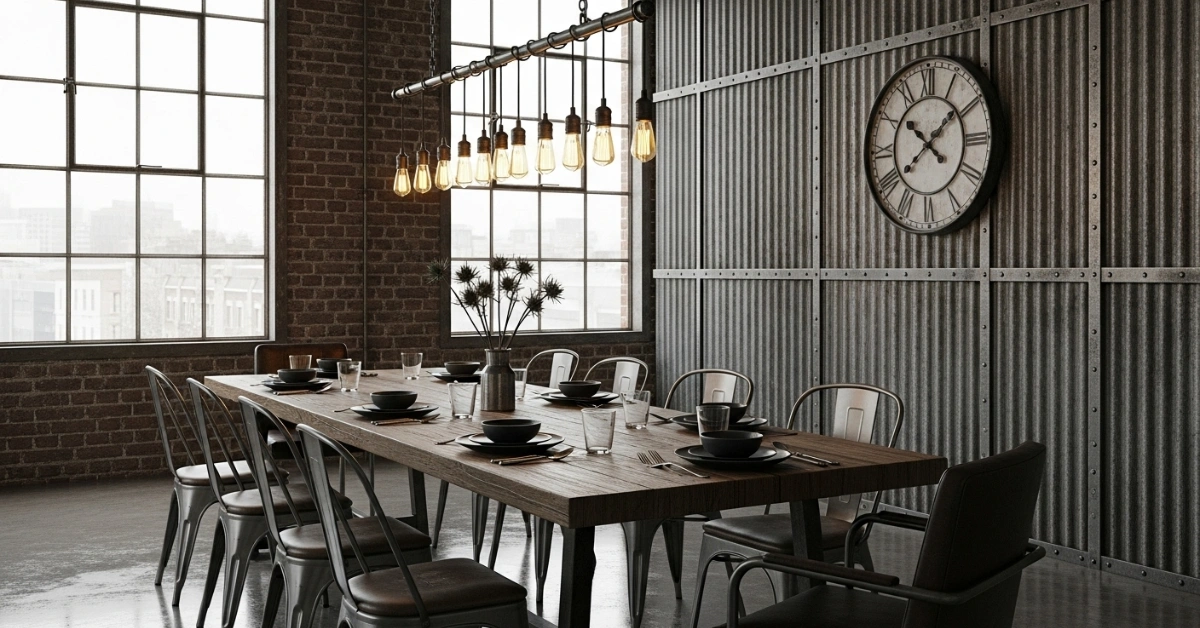
Designing a dining room that feels both stylish and functional can be a challenge, especially when you want a space that stands out without feeling cluttered or dated. Many homeowners struggle to balance bold aesthetics with practicality, often ending up with a room that feels uninspired or overly sterile.
The solution lies in the industrial dining room style a perfect blend of raw, rugged charm and modern sophistication. This design trend, rooted in the utilitarian beauty of old factories and warehouses, offers a versatile canvas for creating a warm, inviting, and timeless dining space. In this comprehensive guide, we’ll explore everything you need to know to craft an industrial dining room, from core elements and material choices to practical tips and inspiring ideas.

What Is the Industrial Dining Room Style?
The industrial design aesthetic draws inspiration from early 20th-century factories, lofts, and warehouses. It celebrates raw materials, exposed textures, and functional forms, creating spaces that feel authentic and lived-in. In a dining room, this style translates into a mix of sturdy furniture, metallic accents, and neutral tones, often softened with warm lighting or natural elements.

Key Characteristics of an Industrial Dining Room
- Raw Materials: Think exposed brick, reclaimed wood, concrete, and metals like steel or iron.
- Neutral Color Palette: Shades of gray, black, brown, and white dominate, with occasional pops of muted color.
- Functional Design: Furniture and decor prioritize utility while maintaining aesthetic appeal.
- Open Space: Industrial dining rooms often feel spacious, with minimal clutter and open layouts.
- Textural Contrast: Combining rough textures (like distressed wood) with sleek ones (like polished metal) creates visual interest.

“Industrial design is about embracing imperfections and letting the materials tell a story,” says interior designer Sarah Thompson. “In a dining room, it’s about creating a space that feels both grounded and effortlessly cool.”
Why Choose an Industrial Dining Room?
This style is ideal for homeowners who want a space that’s modern yet timeless, functional yet stylish. Here’s why it’s a great choice:
- Versatility: Industrial elements pair well with other styles, like Scandinavian or rustic, allowing for personalization.
- Durability: Materials like metal and reclaimed wood are built to last, making them perfect for high-traffic dining areas.
- Low Maintenance: The rugged aesthetic embraces wear and tear, so scratches or scuffs only add character.
- Timeless Appeal: Unlike trendy designs that fade, industrial style has staying power due to its classic roots.

Core Elements of an Industrial Dining Room
To create an authentic industrial dining room, focus on these essential components. Each element contributes to the overall aesthetic while ensuring the space remains functional and inviting.
1. Furniture: Sturdy and Statement-Making
The dining table is the centerpiece of any dining room, and in an industrial setting, it should feel substantial yet simple. Opt for tables made from reclaimed wood, often paired with metal legs or frames for a rugged look.
- Dining Tables: Choose a large, rectangular table with a distressed wood top or a sleek concrete surface. For smaller spaces, a round table with a metal base works well.
- Chairs: Mix and match styles, like metal Tolix chairs or wooden seats with leather upholstery. Avoid overly ornate designs—keep it clean and functional.
- Storage: Incorporate a metal or wood buffet for storing dishes, or use open shelving to display serveware with an industrial edge.

Pro Tip: “A mismatched set of chairs can add personality to an industrial dining room,” says designer Mark Evans. “Just ensure they share a common material or color to tie the look together.”
2. Materials: Raw and Refined
Materials are the heart of industrial design. Combine raw, textured surfaces with polished accents to strike the right balance.
- Wood: Reclaimed or distressed wood adds warmth and history. Use it for tables, flooring, or accent beams.
- Metal: Steel, iron, or brass accents in light fixtures, chair frames, or decor create an industrial edge.
- Concrete: A concrete floor or tabletop adds a sleek, modern touch. Polished concrete is easier to clean and maintain.
- Brick: Exposed brick walls, whether real or faux, are a hallmark of industrial style, adding texture and depth.

Real-World Example: In a recent project, I helped a client transform their dining room by installing a reclaimed wood table paired with black metal chairs. The addition of a faux brick wall instantly gave the space an urban loft vibe, proving that small changes can make a big impact.
3. Lighting: Warm and Dramatic
Lighting sets the mood in an industrial dining room, balancing the raw materials with warmth. Opt for fixtures that blend form and function.
- Pendant Lights: Large, metallic pendant lights with exposed bulbs are a classic choice. Hang them low over the dining table for drama.
- Edison Bulbs: These vintage-style bulbs add a warm, nostalgic glow. Use them in chandeliers or standalone fixtures.
- Wall Sconces: Metal sconces with a weathered finish can flank a buffet or artwork for added ambiance.

Pro Tip: Dimmer switches are a must for industrial dining rooms. They allow you to adjust the lighting for casual dinners or formal gatherings.
4. Color Palette: Neutral with Depth
Industrial dining rooms rely on a muted color palette to create a cohesive look. Stick to neutral tones, but layer them for depth and interest.
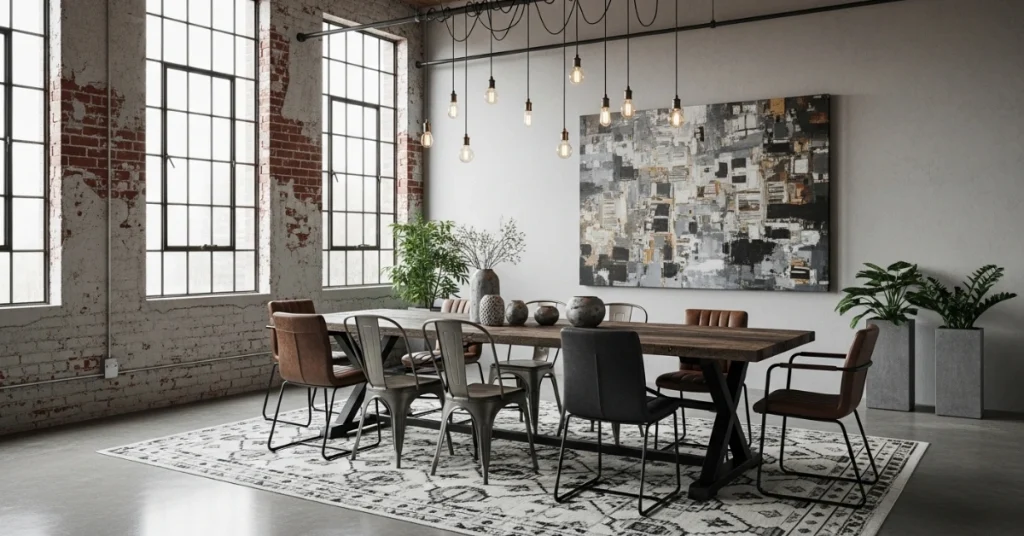
| Color | Role in Industrial Design |
|---|---|
| Gray | Base color for walls, floors, or furniture |
| Black | Adds contrast in metal accents or furniture frames |
| Brown | Warmth from wood or leather elements |
| White | Brightens the space, often used on walls or ceilings |
| Muted Accents | Subtle greens, blues, or rust tones for decor |
Pro Tip: If you want a pop of color, incorporate it sparingly through accessories like cushions, rugs, or artwork.
5. Decor: Minimal but Impactful
Industrial dining rooms thrive on minimalism, but the decor should still feel personal and curated.
- Artwork: Black-and-white photography, abstract prints, or vintage signs add character without overwhelming the space.
- Plants: Greenery softens the rugged aesthetic. Try potted succulents or a large floor plant in a concrete or metal pot.
- Textiles: Use leather or canvas for chair cushions or table runners to add warmth without cluttering the space.

Designer Insight: “Less is more in an industrial dining room,” says designer Laura Bennett. “Choose one or two bold decor pieces to make a statement, like a large vintage clock or a salvaged factory sign.”
Designing Your Industrial Dining Room: Step-by-Step Guide
Ready to bring the industrial aesthetic to your dining room? Follow these practical steps to create a space that’s both stylish and functional.
Step 1: Assess Your Space
Before diving into design choices, evaluate your dining room’s size, layout, and natural light.
- Small Spaces: Opt for a round table and wall-mounted shelving to save space. Mirrors can make the room feel larger.
- Large Spaces: Use a long rectangular table and bold lighting fixtures to fill the area without overwhelming it.
- Natural Light: If your room lacks windows, incorporate reflective surfaces like polished metal or glass to brighten the space.

Step 2: Choose a Focal Point
Every industrial dining room needs a standout feature. This could be:
- A large reclaimed wood dining table.
- An exposed brick wall or concrete accent.
- A dramatic chandelier with Edison bulbs.

Real-World Example: In a client’s home, we made a reclaimed wood table the focal point, pairing it with sleek black metal chairs and a single oversized pendant light. The result was a cohesive, eye-catching space that felt both modern and inviting.
Step 3: Layer Textures and Materials
Combine materials to create contrast and depth. For example:
- Pair a wooden table with metal chairs.
- Use a concrete floor with a soft wool rug.
- Add leather cushions to wooden benches for warmth.

Pro Tip: Avoid overusing one material. Too much metal can feel cold, while too much wood can feel heavy. Balance is key.
Step 4: Incorporate Functional Storage
Dining rooms need storage for dishes, linens, or decor. Industrial-style storage options include:
- Open metal shelving for displaying plates or glassware.
- A reclaimed wood buffet with metal hardware.
- Vintage crates or baskets for a rustic touch.

Step 5: Add Personal Touches
Make the space feel like yours with personal elements:
- Display family heirlooms, like a vintage tray or candlesticks.
- Hang artwork that reflects your personality, such as industrial-inspired sketches or photos.
- Incorporate plants or herbs for a touch of nature.
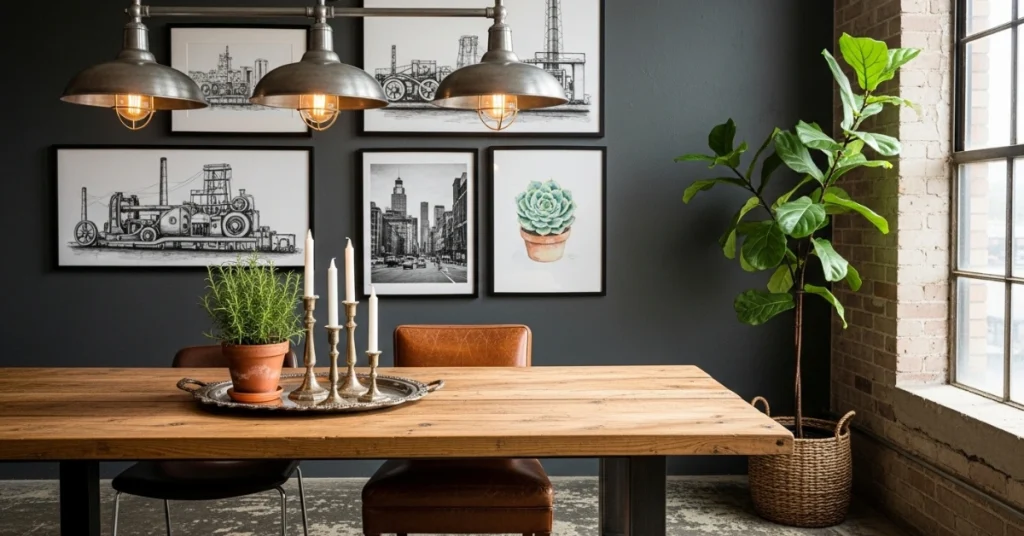
Industrial Dining Room Ideas for Inspiration
Need some creative ideas to get started? Here are 10 industrial dining room designs to spark your imagination:
Urban Loft Vibes:
Combine an exposed brick wall, a reclaimed wood table, and black metal pendant lights for a classic industrial look.

Minimalist Industrial:
Use a sleek concrete table, white walls, and simple metal chairs for a clean, modern aesthetic.

Rustic Industrial Fusion:
Pair a distressed wood table with leather-upholstered chairs and a wool rug for warmth.

Vintage Factory Charm:
Incorporate salvaged factory elements, like a metal chandelier or vintage signage, for authenticity.

Monochrome Elegance:
Stick to a black-and-white palette with metal accents and geometric artwork.

Cozy Industrial:
Soften the look with plush cushions, a woven rug, and warm Edison bulb lighting.

Industrial with Color:
Add muted green or rust accents through chair upholstery or decor for a subtle pop.

Open-Plan Dining:
Use a long dining table to anchor an open-plan space, paired with industrial shelving to define the area.

Eclectic Industrial:
Mix vintage and modern elements, like a reclaimed wood table with colorful metal chairs.

Small-Space Industrial:
Opt for a round table, wall-mounted shelves, and a single bold light fixture to maximize space.

Common Mistakes to Avoid in an Industrial Dining Room
Even with the best intentions, it’s easy to make design missteps. Here are some pitfalls to avoid:
- Overloading with Metal: Too much metal can make the space feel cold. Balance it with wood or textiles.
- Ignoring Lighting: Harsh overhead lights can ruin the ambiance. Use warm, dimmable lighting instead.
- Cluttering the Space: Industrial style thrives on simplicity. Avoid overcrowding with too many decor pieces.
- Choosing Fragile Materials: Delicate furniture doesn’t suit the rugged aesthetic. Opt for sturdy, durable pieces.
- Forgetting Comfort: Industrial dining rooms should feel inviting. Add cushions or rugs to soften the space.
Budget-Friendly Tips for an Industrial Dining Room
Creating an industrial dining room doesn’t have to break the bank. Here are some cost-effective ideas:
- DIY Brick Wall: Use peel-and-stick brick wallpaper for an affordable alternative to real brick.
- Shop Secondhand: Look for reclaimed wood tables or metal chairs at thrift stores or flea markets.
- Repurpose Items: Turn old crates into shelves or use mason jars as candleholders.
- Paint It: A fresh coat of matte black or gray paint can transform old furniture into industrial chic.
- Focus on Lighting: A single statement light fixture can elevate the space without a major investment.
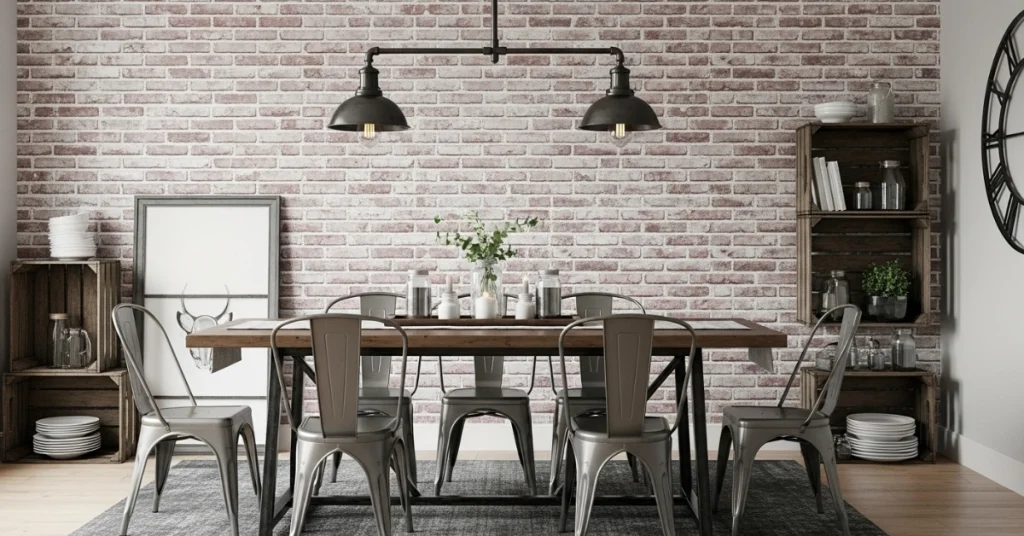
Real-World Example: A friend recently revamped their dining room on a budget by sourcing a secondhand wood table and painting it with a distressed finish. They paired it with affordable metal chairs from a discount retailer, creating a stunning industrial look for under $500.
Industrial Dining Room Trends for 2025
The industrial style evolves with time, and 2025 brings fresh takes on this classic aesthetic. Here are some trends to watch:
- Sustainable Materials: Reclaimed wood and recycled metal are gaining popularity for eco-conscious designs.
- Mixed Metals: Combining brass, copper, and steel adds warmth and sophistication.
- Bold Textures: Textured walls, like shiplap or concrete, are making a comeback.
- Smart Lighting: Industrial-style fixtures with smart controls offer both style and convenience.
- Biophilic Elements: Incorporating plants or natural fibers softens the industrial edge.

Source: According to a 2024 report by Houzz, 68% of homeowners are prioritizing sustainable materials in their home renovations, making eco-friendly industrial designs a top trend.
Conclusion: Your Dream Industrial Dining Room Awaits
An industrial dining room is more than just a place to eat, it’s a space where style, function, and personality collide. By blending raw materials, neutral tones, and thoughtful decor, you can create a dining area that’s both timeless and inviting. Whether you’re working with a spacious loft or a cozy apartment, the ideas and tips in this guide will help you craft a dining room that inspires and delights.
Ready to get started? Begin by assessing your space, choosing a focal point, and layering textures for a balanced look. Share your industrial dining room journey with us in the comments or explore our curated collection of industrial furniture and decor to bring your vision to life!



